Actually, I guess the first couple of photos here are from March. (1) We hadn’t been to Old Town San Diego in a while and made a quick pilgrimage there one day during Wonderboy’s spring break. (2) Rilla’s bunny chain—entirely her own design—is the best Easter decoration I’ve seen in a long time. Those ears!
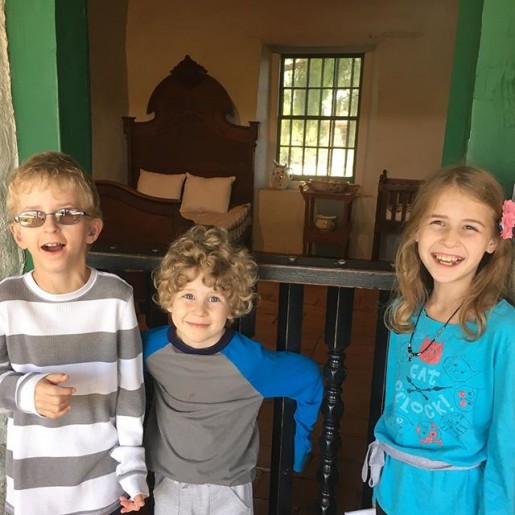
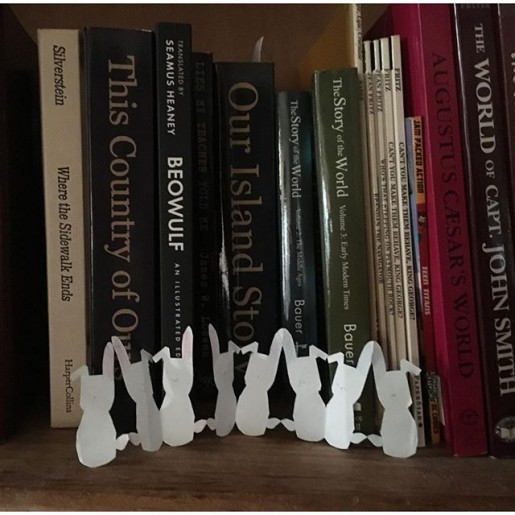
April for real:
(3) How Huck likes to rock his Math-U-See.
(4) Library day. I want that Eric Carle rug!
(5) Another library-day shot. What I love most about this photo is that the bed they’re on belongs to neither of them. It’s Beanie’s—the bottom bunk, which has long been the favorite place for my girls to sprawl. Beanie, meanwhile, does most of her own sprawling on Rilla’s bed. Go figure.
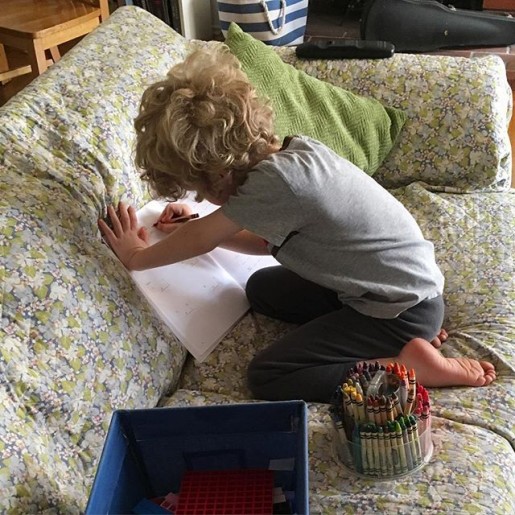
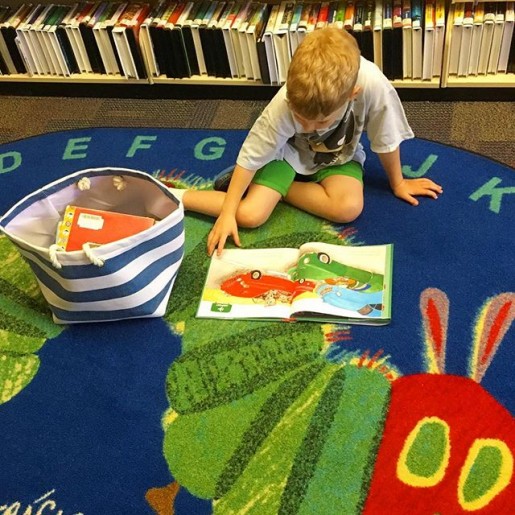
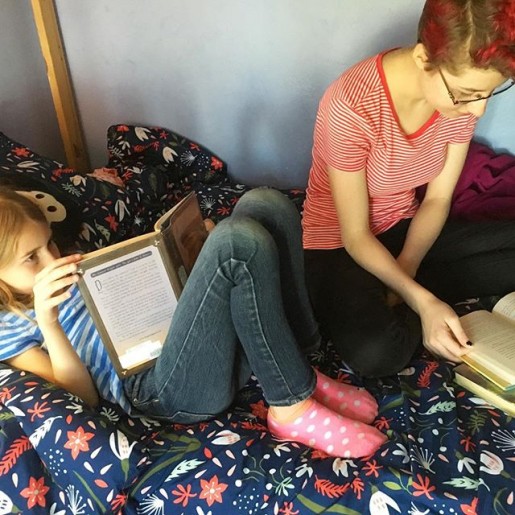
(6) Monarch caterpillar on our milkweed: always a sight that brings me joy.
(7) Wonderboy raised these sunflowers from a handful of old seeds spilled in the bottom of a bag of mostly-empty seed packets. The color surprised us!
(8) Also a surprise this year: the giant blooms on a neglected rosebush by our patio. Loads of them! It’s like Valancy went at the bush with her clippers.
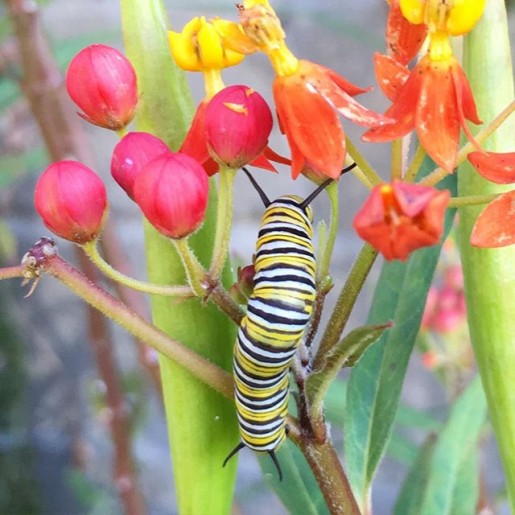
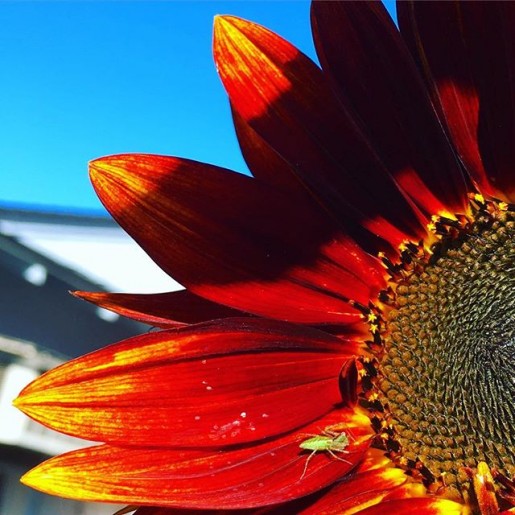
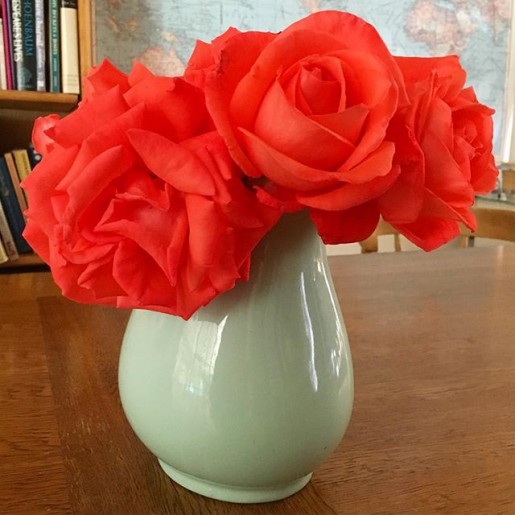
(9) Playing with a Hobonichi Techo-style layout in my bullet journal. Mary Ann Scheuer and I had a fun Skype session last week to chat about my bujo system. What’s working these days: Separate books for my messy notes and my bullet lists. It’s sort of a left brain/right brain thing: I need a space for scribbly notes of all kinds, an unkempt, all-purpose thinking-on-paper space; but I also need nice, neat(ish) to-do lists with boxes I can fill in as I accomplish tasks. It took me a LOT of years—and the revelation of the multiple-insert traveler’s notebook—to figure this out: that I need the two separate spaces.
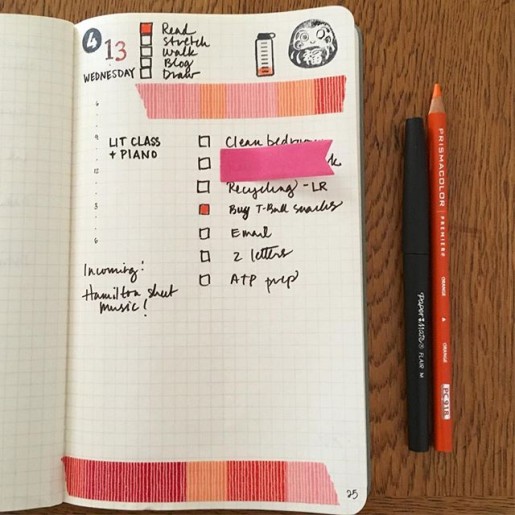
Yay, now I can fill in that ‘blog’ box!
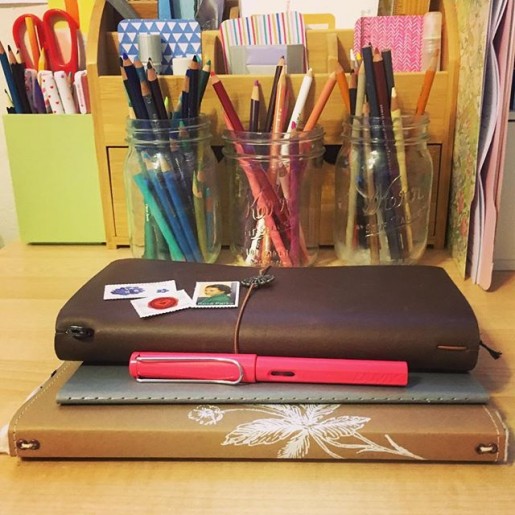
My everyday favorites. After a year of experimenting, I’ve got my system figured out. Top to bottom:
• Midori Travelers Notebook for my monthly calendar, weekly journal, and a scribble notebook;
• Moleskine Cahier for daily to-lists (bullet journal);
• Wild Simplicity Daybook for homeschooling notes and records (including our weekly Shakespeare lines—we learn monologues two lines at a time); and
• the Lamy Safari fountain pen my family gave me for my birthday. (LOVE.) (That’s an Amazon affiliate link but if you’re buying pens in the U.S., you should order from the nice people at Goulet Pen Company. Their instructional videos are invaluable, their customer service is top notch, and they offer inexpensive ink samples so you can try out all sorts of gorgeous colors. And that is not an affiliate link. I’m just a happy customer.)
I still keep the family appointments on Google Calendar, but I enjoy writing everything out in the TN monthly calendar (#017) as well. I use the horizontal weekly TN insert (#019) for chronicling the day after it happens—just a few notes about highlights. For the last several months I’ve used a blank TN insert (#003) for my bullet journal but came to realize I need a separate space for scrawling, sketching, doodling, working things out on paper. If I do that in the bullet, things get messy. WAY messy. So I’ve gone back to my old (cheaper) Moleskine grids for task lists.
The Midori travels with me everywhere; the bullet journal lives on my desk where I do most of my work; and the Daybook has a home in a basket by my rocking chair in the living room.
I’m laughing at how complicated this must seem if you aren’t a pen-and-paper fanatic…but I juggle a lot of roles (and kids) and I find having different paper spaces helps me keep things straight.
More nitty gritty:
I also have a kraft folder (#020) in my Midori to tuck ephemera and snail-mail supplies into. Since I started carrying notecards and stamps around, I’ve gotten much more prompt with my thank-you notes.
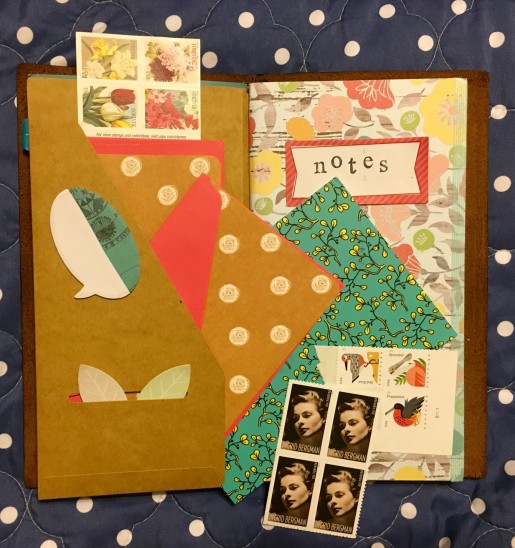
• I love the feel of Prismacolor colored pencils on the paper Lesley Austin uses in the Wild Simplicity Daybook. I’m sure I’ve raved about this before—the lovely creamy pencil on this recycled paper with just the right amount of tooth.
• Prismacolor pencils also delight me in the bullet journal: I like ’em for filling in my checkboxes.
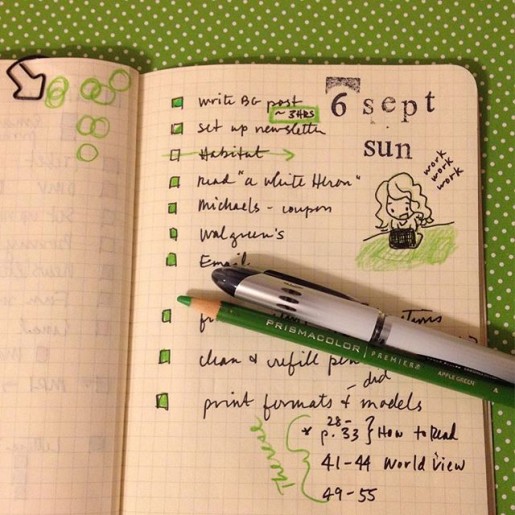
• This pic, which I’ve shared here before, shows my favorite way to organize a task list: to-do items on the right, and the verso is for related notes and numbers. I also keep a running “Nag List” on a sticky note that travels from spread to spread. It’s for important tasks that I might not get done today but I gotta deal with soon—like finishing my taxes or booking a doctor appointment. I consult it each evening when making out my bullet list for the next day.
• Sometimes I’ll tuck another insert into the Midori to be used for a specific purpose. For example, I keep a log of incoming and outgoing snail mail. I don’t like a superfat Midori, though, so more often that insert lives in my stationery pouch.
• As I mentioned, I do a lot of casual sketching in my blank Midori insert. I find I’m often more comfortable there than in my proper sketchbook, because it feels more casual. But I do have a couple of sketchbooks going and I try to work in at least one of them daily. One is a spiral-bound 7×10 Canson Mixed Media pad, which gets lukewarm reviews from real artists but I quite like its toothy paper—not to mention its price point when Michael’s has a good sale + coupon combo. You have to watch for it, but now and then they’ll give you a 20% off including sale items coupon during a buy-one-get-one-free sketchbook sale. My other sketchbook is a Moleskine Art Plus, and it’s…okay? I love its size and shape (fits nicely in my bag), but the paper is too smooth for my liking. I much prefer the feel of Moleskine’s watercolor sketchbook—a lovely texture to that paper. But so far I’ve mostly just used that for color charts.
• For sketching pens, I like Sakura Pigma Microns or my Pilot Metropolitan fountain pen (check out all the groovy colors at Goulet Pens) with Platinum Carbon ink, which is waterproof so it plays nice under watercolors. However, lately I’ve come to realize that what I enjoy most of all is sketching in pencil. I love the look of black or brown ink drawings, and most of the sketchbook artists I admire work directly in ink, but I really love the way a pencil feels on the paper. I keep hitting that point over and over, don’t I—the tactile experience matters more to me than how it looks.
Ha, this got long! Would you believe it was just going to be a quick copy-paste of something I tossed on Instagram today?
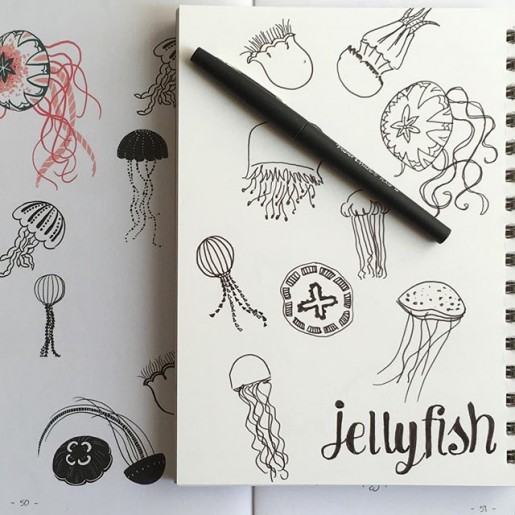
It started, I think, with my commitment to a daily sketching habit in the fall of 2014. By last January, the habit was firmly established, and I only missed a handful of days all year. January is also when I started taking “kourses” at Sketchbook Skool—which exposed me to not just the lessons and work of accomplished artists, but also to their media of choice. Which is to say: they have firm opinions about pens, making them my kind of people.
Putting pen to paper in my sketchbook reminded me how much I love that feeling. Now, I have never enjoyed doing large amounts of handwriting—I can’t write my books longhand, for example. My wrist aches after a couple of pages. But I love penmanship: other people’s, mainly. My handwriting is changeable and seldom neat. I never managed to commit to one way of shaping letters, so I wind up with different kinds of I and r and k all in one line. Last night I was numbering pages in a new bullet journal and realized that some of my 4s were the pointy kind and some were not. Happens all the time. I like change, y’all.

Anyway—I can’t write volumes by hand all at once, but I adore the feeling of a good pen on the right kind of paper. Experimenting with various pens (Pigma Micron, Le Pen, Pilot Metropolitan, Lamy Joy with 1.1 nib) reminded me how much I love analogue notetaking. So while I still find apps like Workflowy useful for tracking particular kinds of tasks, in the past few months I have shifted almost entirely to written notekeeping.
Notes on paper
Bullet journaling works very well for me. I’ve always kept a notebook as an idea and memory catch-all: phone call records, tasks completed, shopping lists, story ideas, doodles—it all winds up in the notebook in a giant jumble. Adding a bullet-journal-style index and page numbers was a revelation: now I can have my hodgepodge but find things later. Perfect.
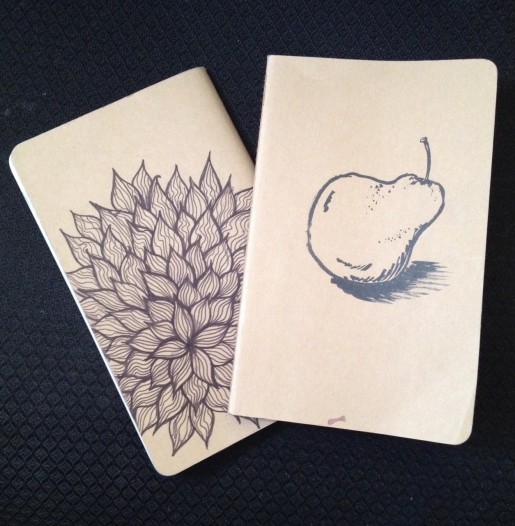
For the first part of this year I used kraft-brown Moleskine Cahiers. They’re just the right size for tucking in my bag, they’re sturdy enough to handle the beating I give them, and they fill up in a month or two which means the continual fresh start I love. Then, in August, a glorious friend surprised me with a Midori Traveler’s Notebook. It was love at first sniff. I mean, I. JUST. ADORE. THIS. THING.
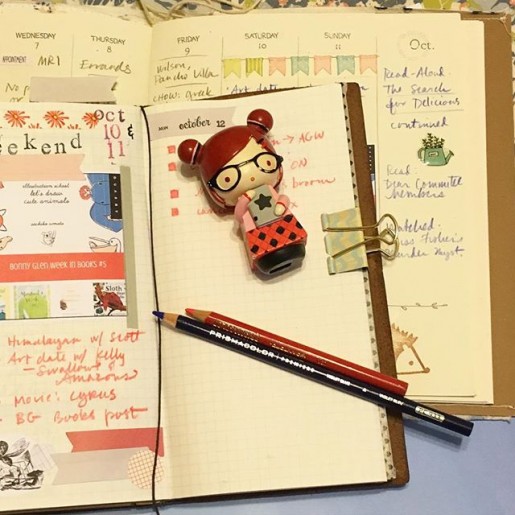
A traveler’s notebook, if you don’t know, involves a cover (usually leather, sometimes cloth or vinyl) that has a sturdy elastic cord or two strung through the spine. You slip a paper notebook under the cord to hold it in place. Then you can use additional bands to hold other inserts—various types of notebooks, folders, calendars, even plastic credit-card sleeves or zipper pouches.
My Midori set-up
After playing with my Midori for a month or two, I settled into the configuration that works best for me: a weekly calendar insert, a grid notebook, and a kraft folder that holds stickers, postage stamps, notepaper, and such. I keep a monthly calendar, too, but I don’t need to carry the whole year around with me so I have begun photocopying (and shrinking a bit) the current month and clipping that to my weekly page.

The blank grid insert is my bullet journal/idea repository/casual sketchbook, replacing the Moleskine Cahier. I number the pages and use the first page as an index, just as before. I like big fat checkboxes for my task lists, which I fill in with Prismacolor pencil as tasks are completed. Color is my happy place.  I also like to paste in ephemera and sometimes embellish with stamps, doodles, or washi tape. Basically, these inserts become collages of all the things that occupy my days and my mind. I seem to do a fair amount of sketching in them, too, even though I have an actual sketchbook for that purpose—I work in the real sketchbook daily but the TN grid insert is a low-pressure place to experiment, and I always have it with me.
I also like to paste in ephemera and sometimes embellish with stamps, doodles, or washi tape. Basically, these inserts become collages of all the things that occupy my days and my mind. I seem to do a fair amount of sketching in them, too, even though I have an actual sketchbook for that purpose—I work in the real sketchbook daily but the TN grid insert is a low-pressure place to experiment, and I always have it with me.
Thanks to Lesley Austin’s beautiful Wild Simplicity Daybook designs, I discovered that a week-on-two-pages spread is an excellent space for me to do some chronicling. I’ve posted before about how I use the Daybook for recording homeschooling and housekeeping notes. I really like having a separate space (and such a beautiful one) for those things. I wear so many hats, and I need ways to keep my roles sorted. The Daybook (visible under my Midori in a photo above), like all of Lesley’s paper goods, conveys a sense of peace and serenity, and so it has become a really nourishing space for me to jot down my notes about what the kids read, did, said. I always feel so happy when I open that book.
Taking a cue from that experience, I decided to try the Midori week-on-two-pages for my TN. The version I selected (Refill #19) has the week in seven horizontal boxes on the left page, and a grid page for notes on the right. I use Google Calendar for our family appointments and schedules, so a couple of times a week I open G-Cal and add any new appointments to the Midori insert. At the end of each day, I create an entry on the weekly calendar page, filling it with notes about what happened that day. It isn’t a to-do list, it’s more like a diary. Not what needs to be done (that’s what the bullet journal is for), but what I actually did. The facing page fills up with quotes, ephemera, drawings, and notes on things I’ve read or watched.
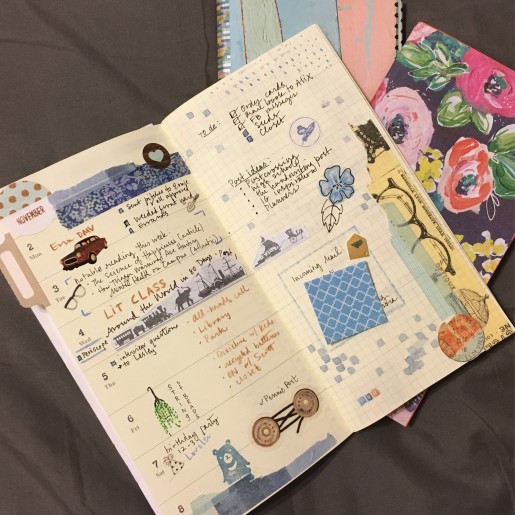
Since these pages serve as a kind of journal, I like to decorate them with washi, drawings, and watercolors. I wind up doing the ornamenting mostly on weekends. Often, I’ll start the week with two or three colors of washi in front of me, and that will set the tone for my week. This daily decorating is relaxing, it takes only moments, and I enjoy paging back through previous weeks.
So those are the two main TN inserts I carry around: the weekly calendar for journaling (more or less), and the grid notebook (Refill #2) for everything else. Those two inserts plus the kraft folder (Refill #20) make the Midori as fat as I like it to get. I could easily come up with uses for half a dozen more inserts (the TN’s capacity for letting you compartmentalize is its genius), but I found that I really prefer a non-chunky Midori.
However! I did decide to devote a single insert to all medical and health-insurance-related notes, and this has been one of my best moves ever. Instead of having those notes intermingled with everything else, they live in their own space now, with a list of phone numbers on the first page. I can tuck THAT insert into the Midori when we’re heading to an appointment. It’s perfect.
NEED MOAR PAPER
All this notebooking served to increase the satisfaction I was finding in putting pen to paper. And I found I was thinking about handwriting a lot. My little goddaughter sent me a thank-you note, and her mother’s handwriting on the envelope—the gorgeous, familiar handwriting that graced pages and pages of letters in the years after college when Krissy and I wrote to each other constantly—gave me a little jolt of joy and nostalgia. I hadn’t seen her writing in a while, and I missed it. I told her (via text, naturally) how happy I’d been to see her writing, and she said the same thing had happened to her when she saw my writing on the package I’d sent her daughter.
Shortly after that, I read that Atlantic article that was making the rounds about how the ballpoint pen killed cursive. Fascinating stuff, but the bit that grabbed me was this: “In his history of handwriting, The Missing Ink, the author Philip Hensher recalls the moment he realized that he had no idea what his good friend’s handwriting looked like. ‘It never struck me as strange before… We could have gone on like this forever, hardly noticing that we had no need of handwriting anymore.'”
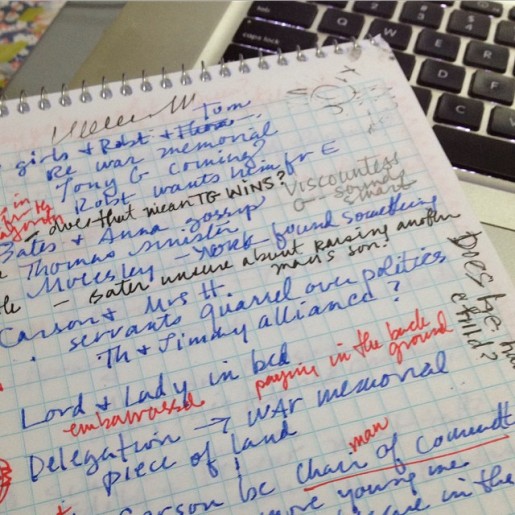
He had no idea what his good friend’s handwriting looked like. I miss handwriting, I thought. The distinct and beloved scripts of my old friends flashed before my eyes. I’d know those hands anywhere, could pick them out of any penmanship lineup. My kids probably won’t experience that. Jane has friends on the other side of the country she talks to via electronic means every single day, but they probably don’t know each other’s handwriting. I have plenty of friends myself whose writing I’ve never seen. If we met after 1995, chances are I’ve seen your handwriting seldom or never. (Tanita! What’s your writing like?)
Channeling my inner Jane Austen
The handwriting epiphany spurred me to the next phase of my analogue journey: I started writing letters again. Like, by hand. I have penpals in Denmark, France, Austria, and England, as well as various friends across the U.S.
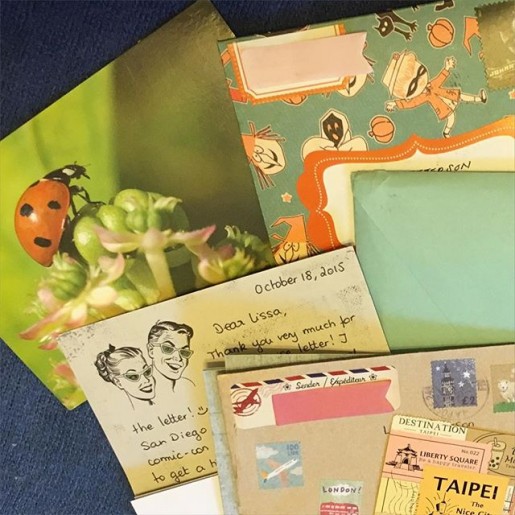
I’m amused and a little baffled that for so many years I thought of letters owing replies as a kind of guilt-ridden chore—I always took forever to answer, always had them nagging in the back of my mind. Because the truth is: snail mail is the cheapest fun around. Sure, they’re slower to write than email; slower to arrive than a Facebook message. But that’s part of the charm: the slowing down, the taking time. Just as many of us have (re)discovered the joys of slow reading in the past couple of years, I have found satisfaction in…what to call it? Not slow writing, really, because part of the point is that instead of waiting months or even (gulp) years to answer a letter, I now try to reply within three weeks; I guess what I’m enjoying isn’t about speed (or lack of it) after all. It’s about a tactile experience. The skritch of a fountain pen on flecked paper. The careful selection of stamps. The smoothing-out of a bit of washi tape across a seal. The rustle of envelopes as they slide into the box, slumbering before their journey to places I’ll never go.
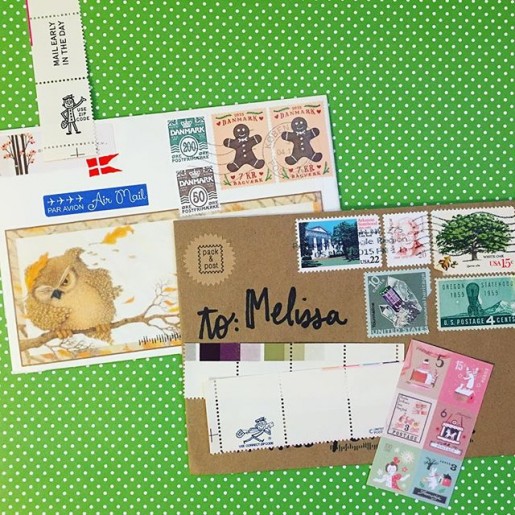
And best of all: the incoming letters. Foreign stamps, unfamiliar scripts, universal experiences. Beautifully decorated, many of them—it’s like getting mail from Griffin and Sabine. This one written at a café in Vienna; that one at a Starbucks in Portland. Kaleidoscopic glimpses of a life gradually resolving into a picture. We talk about things we could easily tell via email, but we’ve decided to let these stories take the scenic route. Some of them never arrive, or show up months later, ragged and stained. This only makes us love them more.
I’m writing to say I’ll write soon
A piece of the experience that affords me much merriment is the impulse, whenever a letter arrives, to hurry to Facebook and ping the friend who sent it. “Got your letter! Will reply soon,” I’ll write, and “Yay, can’t wait!” she’ll ping back. Never mind that the letter asks questions which could be more immediately answered via any of a dozen digital platforms. The answers will keep. Come Saturday afternoon, I’ll settle in with my cocoa, my envelopes, my wonderful new pink Lamy Safari that I got for my birthday. Which paper—the whimsical or the lovely? The fern stamps, or the Ingrid Bergmans? I’m almost out of globals, and the post office won’t have the new ones for a while. But have you seen them, the moons? I’m already imagining them on dark blue envelopes…
Our digital and analogue worlds will forever be intertwined, I believe. We’ll snap photos of our beautiful incoming mail to share on Instagram, hashtagged so our kindred spirits can find and enjoy it. We’ll trade addresses on Facebook. We’ll email to find out if that letter ever arrived. We’ll scour Etsy for traveler’s notebook inserts and stock up on ink at Goulet Pens. We’ll sign up for swaps on websites, and then anxiously check tracking to see when packages might arrive. We’ll reblog Tumblr articles about clever ways to hack a bullet journal. We’ll watch Youtube videos about how to set up a Midori and we’ll tap the heart button a zillion times during an unboxing on Periscope. We’ll link to photos of new USPS stamp releases in our blog posts. 
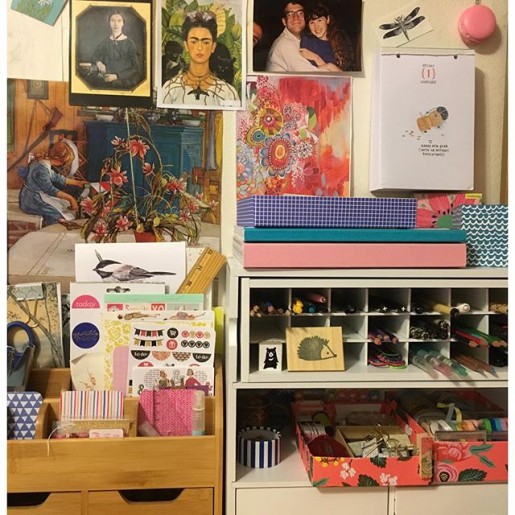
My blog, though, is perhaps the thing that suffered this past year as my attention shifted to paper and ink. I found that when I had a few quiet moments, I was more apt to want to spend them sketching or writing a letter than blogging. After ten years of a steady blog habit, that was a bit of a surprise. In January, this blog will be eleven years old. I’ve successfully figured out how to integrate my analogue and digital calendar-keeping and task-tracking, but it did take a little while for the pieces to settle into place. I expect the same will happen with blogging.
Happy New Year, friends!

As a member of Wisteria & Sunshine, Lesley Austin’s gentle online community for home-and-hearth inspiration, I’ve had the fun of watching behind the scenes as her beautiful new Wild Simplicity Daybook took shape. Today is a day to celebrate, because the Daybook has landed in her Etsy shop!

It’s a Midori-style cover made with the tender eco-friendly consciousness that suffuses all Lesley’s handmade wares, and she has created a selection of inserts to let you customize your Daybook for your own use. I’m particularly fond of Lesley’s monthly calendars (I’ve been using them in one form or another for almost a decade!), and her new weekly diary pages are the loveliest I’ve seen anywhere. She offers them in insert booklets spanning three months at a time, with the Autumn and Winter inserts currently available.
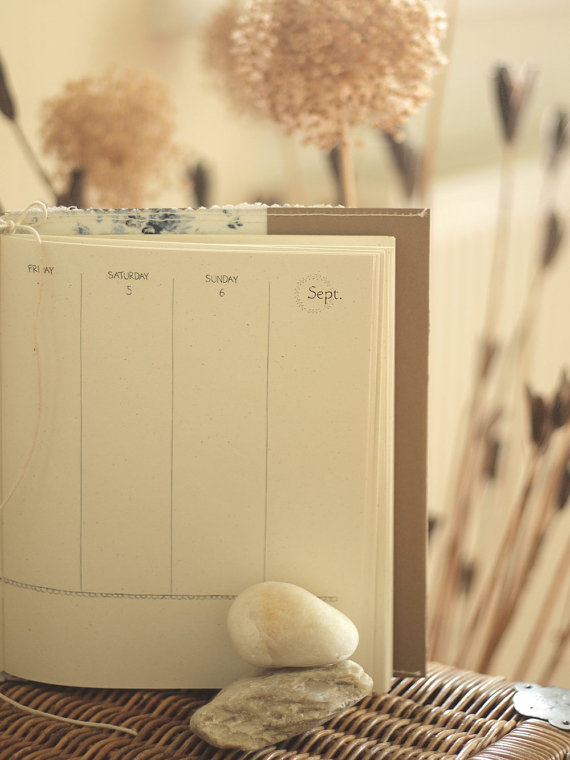
Besides the monthly and weekly calendar inserts, she is also offering blank inserts for notes or journaling and a “Days to Keep” booklet for recording birthdays, anniversaries, and other special dates.
This probably sounds like a sponsored post, but it isn’t! And Lesley didn’t ask me to write it. I am a longtime fan of her paper goods who has had the pleasure of becoming Lesley’s friend as well, and I’m so excited to see her latest venture take flight. Recently I was chatting with another friend about things we love, and I said, “I think my aesthetic is one part Waldorf kindergarten, one part library, and one part Small Meadow Press.” 
OHR Editors’ Note: In April, we put out a call for oral history bloggers. We originally planned to run submissions starting this summer. However, we were so excited by the response that we decided to kick things off a bit early. Enjoy the first of many volunteer posts to come!
By Shanna Farrell
The cocktail is an American invention and was defined in 1806 as “a stimulating liquor composed of spirits of any kind, sugar, water, and bitters.” Cocktail culture took root on the West Coast around the Gold Rush; access to a specific set of spirits and ingredients dictated by trade roots, geography, and agriculture helped shape the West Coast cocktail in particular. We in UC Berkeley’s Regional Oral History Office (ROHO) are beginning a new oral history project about the legacy of the West Coast cocktail, which will explore the cultivation of the West Coast cocktail’s identity and how it has contributed to the return of bartending as a respectable profession. We consider documenting bar culture important, especially because of the current explosion of cocktail bars around the country. However, due to the nature of the topic, this project won’t qualify for academic or grant funding. ROHO has instead had to look for non-traditional funding opportunities, which has presented us with a set of complications that we had yet to experience.
The people involved in the bar and spirit industry have a unique perspective on the ways in which American life has unfolded and intersected around cocktails. When I first began developing this project I reached out to famed bartender Dale DeGroff, cocktail historian and journalist David Wondrich, and PUNCH co-founders Talia Baiocchi and Leslie Pariseau for their insight in identifying interview themes and potential narrators. They are all now serving as our project advisors. We conducted pilot interviews with three Bay Area-based female bartenders and recorded four hours with Wondrich himself. Even early on, themes of community, labor, gender, ethnicity, geography, culinary influence, storytelling and myth making, the dissemination of information, state laws and regulations, bartender/customer relationships, and popular culture have emerged. We hope to interview at least thirty people, including bar owners, bartenders, craft spirit distillers, and cocktail historians, to further unpack these topics.
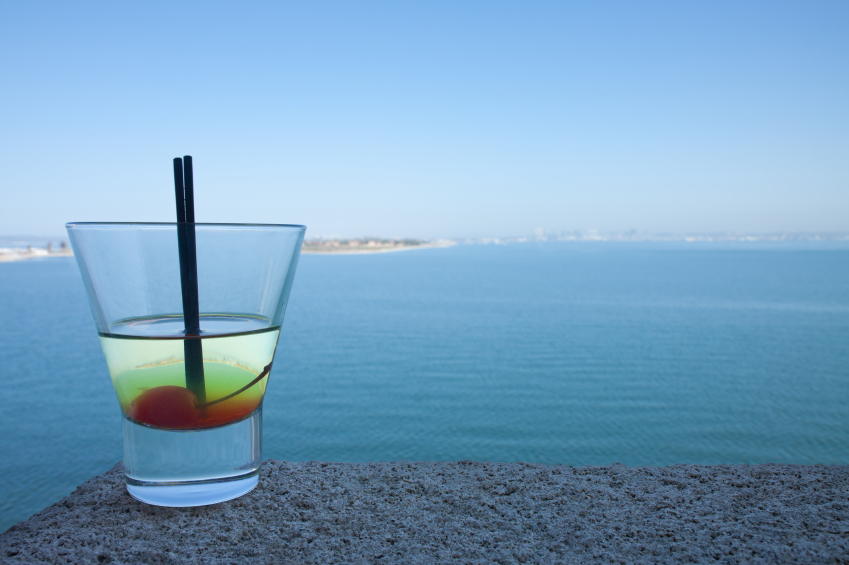
As the project lead, I’ve encountered various issues planning and rolling out the project, especially because of funding. In an attempt to involve the cocktail community, garner interest in the project, and draw people into ROHO’s archives, we decided to raise money through crowdfunding. We’ve been working for several months to get administrative approval, build out partnerships and out network, choose engaging content from our pilot interviews, and build a project website. This has taken a lot of time and though we are optimistic about the success of the campaign, using this funding mechanism is a risk. We are up against a hard deadline to deliver a large amount of content at campaign’s launch on 3 June 2014 and during its following five-week run.
Crowdfunding campaigns usually have a short video (two to three minutes) explaining the concept of the project, the need for financial support, and establishing its legitimacy. We also need to deliver regular updates throughout the five weeks of the campaign to keep our audience interested in the project. This requires pulling clips from interviews that illustrate the project’s exciting topics and themes. For example, we have one story about how Wondrich discovered that pre-Prohibition cocktail recipes called for Holland gin, which is essentially flavored whiskey not readily available in the United States until the past few years, instead of London dry gin, which is flavored vodka and has dominated the domestic gin market for the past twenty years. This proved to be a revelation for Wondrich while writing the hugely influential book Imbibe!: From Absinthe Cocktail to Whiskey Smash, a Salute in Stories and Drinks to “Professor” Jerry Thomas, Pioneer of the American Bar (Perigee Trade, 2007).
Once the campaign is over we will need to share completed interviews with the public as soon as we can to demonstrate that we are using contributions for the intended purpose; this is critical for the project’s reputation if we plan to use this fundraising method in the future. Content will have to be continuously created and sent to narrators for quick approval, which can be difficult due to schedules, file compatibility, and familiarity with technological mediums. Getting clips to narrators in a timely fashion has necessitated our use of free cloud-based technology, such as SoundCloud and Vimeo. Thus far, we have created private tracks on SoundCloud and private channels on Vimeo to share the files in a fast and easily accessible way.
This project will serve as a test for ROHO in many ways: will we be able to produce content, get it to our narrators for approval, and share it publically on a timeline that keeps our audience engaged? Will long-term use of various media outlets like SoundCloud and Vimeo prove successful? Will funders feel satisfied with the level of accessibility of the interviews? Time will tell how the project and its various set of challenges will unfold, but we hope to use digital age techniques to work around the challenges which crowdfunding has presented.
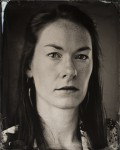 Shanna Farrell is an oral historian in UC Berkeley’s Regional Oral History Office. She holds an MA in Oral History from Columbia University, an Interdisciplinary MA in Humanities and Social Thought from New York University, and a BA in Music from Northeastern University. Aside from her current project on the legacy of the West Coast cocktail, her studies have focused on environmental justice issues in communities impacted by water pollution. Her work includes a community history of the Hudson River, a documentary audio piece entitled “Hydraulic Fracturing: An Oral History” that explored the complexity of issues involved in drilling for natural gas, a study that examined the local politics of “Superfunding” the Gowanus Canal in Brooklyn, New York, and a landscape study of a changing neighborhood in South Brooklyn.
Shanna Farrell is an oral historian in UC Berkeley’s Regional Oral History Office. She holds an MA in Oral History from Columbia University, an Interdisciplinary MA in Humanities and Social Thought from New York University, and a BA in Music from Northeastern University. Aside from her current project on the legacy of the West Coast cocktail, her studies have focused on environmental justice issues in communities impacted by water pollution. Her work includes a community history of the Hudson River, a documentary audio piece entitled “Hydraulic Fracturing: An Oral History” that explored the complexity of issues involved in drilling for natural gas, a study that examined the local politics of “Superfunding” the Gowanus Canal in Brooklyn, New York, and a landscape study of a changing neighborhood in South Brooklyn.
Disclaimer: The views expressed above are that of the author and do not necessarily reflect the views of the OHR editors.
The Oral History Review, published by the Oral History Association, is the U.S. journal of record for the theory and practice of oral history. Its primary mission is to explore the nature and significance of oral history and advance understanding of the field among scholars, educators, practitioners, and the general public. Follow them on Twitter at @oralhistreview, like them on Facebook, add them to your circles on Google Plus, follow them on Tumblr, listen to them on Soundcloud, or follow their latest OUPblog posts via email or RSS to preview, learn, connect, discover, and study oral history.
Subscribe to the OUPblog via email or RSS.
Subscribe to only history articles on the OUPblog via email or RSS.
Image credit: a midori sour on ledge over looking Coronado bay and San Diego. © AndrewHelwich via iStockphoto.
The post Crowdfunding for oral history projects appeared first on OUPblog.

Like some of you may, I listen to a fair amount of Japanese music. In fact, I’ve recently become rather enamored with Kyary-Pamyu Pamyu because dang if her songs are not infectious… Please don’t judge me. I figured I’d do some posts every now and then about Japanese music as it’s relevant to Japanese culture, and a lot of it is rather enjoyable. I must admit, I don’t keep up with the popular J-Rock bands and, with the exception of Kyary, the popular J-Pop stars. My tastes are somewhat off the beaten path. You won’t see any Viz-Kei here, nor will you see any vocaloid, but maybe, if you give yourself the chance, you’ll end up enjoying some of these songs regardless. At the very least, a listen won’t hurt!… Will it?
- Rin Toshite Shigure is a Japanese rock band from Saitama. They’re known for their impressive and varied guitar riffs, their dueling,wailing, male and female vocals, and high-paced intense musical output. Give their song “Telecastic Fake Show” a listen.
- Midori was a Japanese punk band with a heavy jazz influence, an interesting combination if I must say. Led by frantic singer Mariko Goto, this band has high energy and it just pours out song after song. I’ve never heard another band like them. Check out rockin’ live video of their song Yukiko San.
- School Food Punishment, who unfortunately just broke up, is one of my favorite Japanese bands. They’ve gotten some mainstream success and have had their songs of theirs in some anime, like Eden Of The East, [c], and Ungo. Their music is a perfect blend of electronic and rock, fronted with the beautiful vocals of Yumi Uchimura. You May Crawl has remained a favorite of mine for years.
Okay, that’s enough for now. I figure I shouldn’t load everyone with too much off the bat. Though, I do hope you give these bands and these songs a chance, because they’re pretty great. Let me know if you enjoyed any of this stuff or if you want to see more music related posts in the comments or on the facebook page!
…
I lied. There’s one more thing I need to post. As I said above, I’m a big fan of Kyary. Her new video got released and, well, if you’ve seen any of her videos before, this one holds up. Watch it. It’s great.



















 I also like to paste in ephemera and sometimes embellish with stamps, doodles, or washi tape. Basically, these inserts become collages of all the things that occupy my days and my mind. I seem to do a fair amount of sketching in them, too, even though I have an actual sketchbook for that purpose—I work in the real sketchbook daily but the TN grid insert is a low-pressure place to experiment, and I always have it with me.
I also like to paste in ephemera and sometimes embellish with stamps, doodles, or washi tape. Basically, these inserts become collages of all the things that occupy my days and my mind. I seem to do a fair amount of sketching in them, too, even though I have an actual sketchbook for that purpose—I work in the real sketchbook daily but the TN grid insert is a low-pressure place to experiment, and I always have it with me.









